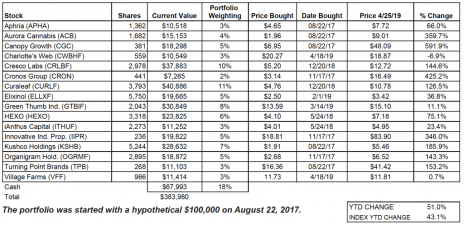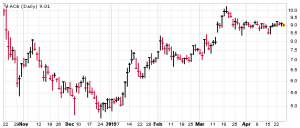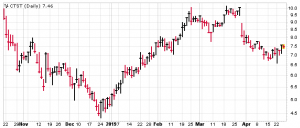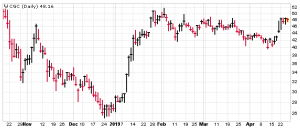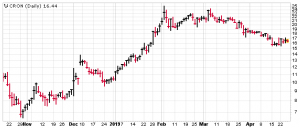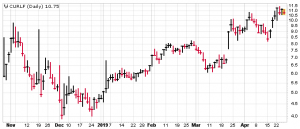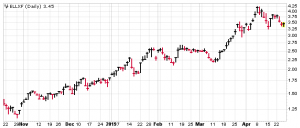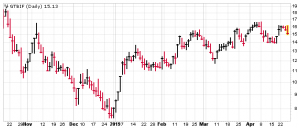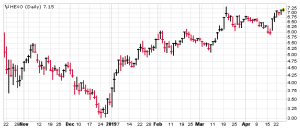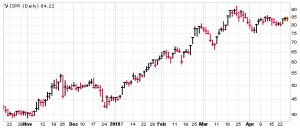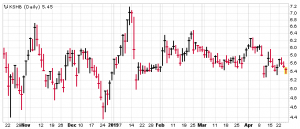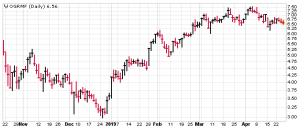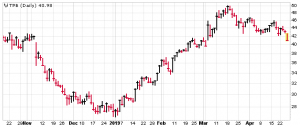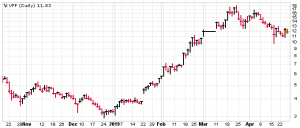The main trend remains up, in both the broad market and the cannabis sector in particular. When these uptrends will end, no one knows, but I guarantee that they will someday.
Long-term, however, I remain very bullish on both the companies and the stocks in the industry and continue to adjust the portfolio’s holdings to optimize growth (with reasonable security.)
Cabot Marijuana Investor 419
Analyzing Stocks
I didn’t go to business school; I was an English major. But the values learned in our household were firmly grounded in free market capitalism and investing. Sunday mornings, after going to church, we would stop at the local newsstand to buy Barron’s, and my father would spend the rest of the day reading it and updating his charts.
I was his first paid employee when this company was launched 49 years ago, typing addresses on envelopes, licking stamps, and eventually learning how to update his precious hand-drawn Relative Performance (RP) stock charts.
Charts, therefore, are in my blood.
While most Wall Street analysts who went to business school learned how to calculate discounted cash flow—and other skills fairly useless when it comes to investing in fast-growing new industries—I learned, directly from my father and his myriad investing books, how to read charts, and thus how to identify the most promising stocks in hot new growth sectors. And this chart-reading has proven to be powerful stuff!
It served us well back when solar power stocks were hot.
It served us well back when Chinese stocks were hot.
And in recent years, it’s been invaluable in helping us identify and buy the leading cannabis stocks.
To those of you who call yourselves chartists, I salute you. And to those of you who do not feel entirely comfortable with charts, I suggest you take a look at Cabot’s Chart School. Learning is a good thing.
Meanwhile, the uptrend in cannabis stocks continues; the wind is at our back and the tide is coming in. However, not all trends are equal. Over the past three months, U.S. cannabis stocks have outperformed their Canadian counterparts—as these charts illustrate.
It’s not entirely necessary to know why this divergence has occurred—but it doesn’t hurt to speculate. For my money, the main factors are these: The Canadian stocks got big first, as cannabis was legalized last October and Constellation Brands and Altria threw billions of dollars into the sector. To some extent, those stocks became overbought. Since then the passing of the Farm Bill has made CBD legal in the U.S., more and more consumers are feeling positive about CBD and marijuana, and more and more institutional money is pouring into the sector (and coming out of the big Canadian stocks), enabling acquisitions that are fattening the leading multi-state operators. At some point, this trend will end, and these stocks too will become overbought—but for now we’re riding the trend.
Multi-State Operators Gain Favor
Here in the U.S., the rush to CBD stocks has morphed into a rush to multi-state operators, not least because Canopy’s plan to buy Acreage has increased the visibility of the group. And deal-making continues, fueled by the continuing flow of cash into the sector.
What’s Next?
Trends tend to continue, so this one is likely to do just that, and I urge you to enjoy it while it lasts. Eventually, something will stop it, and we’ll have another good correction, but it almost certainly won’t be like the one that ended in December.
And what will that something be that causes the correction? It might be the broad market rolling over. It might be talk of overcapicity in the cannabis industry, something that no one is talking about today. It might be something political. Anything is possible. We’ll deal wih it when it gets here.
Investing Strategy
We remain in a real bull market, so you should be heavily invested in a diversified portfolio, always monitoring your portfolio to ensure that your stocks are doing what you hired them to do—or better. Buy on dips, and average up over time.
Also, prepare for a big correction—someday. My plan is to take losses quickly should I have any—that’s always smart—while reducing long-term profitable positions to levels that I feel comfortable holding through thick and thin. And of course, I will listen to the market.
A Word About Low-Priced Stocks
Low-priced stocks are tempting, because you can buy a lot of shares, but it’s not the number of shares you own that matters, it’s the dollars you have invested. So don’t be seduced by low prices. All things being equal, a higher-priced stock is generally safer than a lower-priced stock.
WHAT TO DO NOW
As I write, the portfolio is 17% in cash, as we’ve taken profits in many stocks over the past month, and I’m looking for lower-risk entry points to reinvest the proceeds. But the cash is not burning a hole in my pocket. Today the portfolio is adding a new position in CannTrust (CTST) and averaging up in HEXO (HEXO), taking the portfolio’s cash down to 10% and splitting the proceeds between both stocks.
CURRENT RECOMMENDATIONS
Aphria (APHA)
Aphria is one of the early Canadian leaders in the sector, but a few management mistakes have brought it down a peg, and with a valuation of $2 billion, it’s now ranked fourth among the Canadians. In the long run, prospects are still very good, but in the short term, the company has to recover investor confidence. One step in this direction will be ending the hostile takeover offer from Green Growth Brands that was initiated after APHA plummeted back in December after a short-seller’s critical report questioned the valuation and methodologies of the company’s Latin American acquisitions. Management has addressed those issues, and the stock has recovered decently, but the hostile takeover offer is still out there, clouding the future for both companies. So, in an effort to reduce uncertainty, the companies have collaborated on an Alternative Transaction that will end the hostile takeover offer early and allow them to work together in the future. If you’re a shareholder and you’ve received an offer, you don’t need to do anything. This matter should soon be history.
As for the stock, it now seems to be basing between 7.5 and 8.0. The portfolio has taken profits and remains underweight APHA, waiting for the stock to regain some momentum.
Aurora Cannabis (ACB)
Aurora is the only Canadian major that hasn’t rolled over; the stock continues to trade calmly around 9—which is good—but it remains at risk. Last week the company announced an agreement to buy Hempco, a Canadian provider of quality, hemp-based foods, hemp fiber and hemp nutraceuticals, for $63.4 million, thus obtaining not only a strong global hemp business but also access to the raw material of CBD, which is seeing demand boom in both Canada and the U.S.
CannTrust (CTST)
Joining the portfolio today is CannTrust, a Canadian producer with 450,000 sq. ft. of greenhouse space in Niagara with an additional 390,000 sq. ft. expansion in progress. Its Perpetual Harvest strategy, yielding five to six crops per year, reportedly enables higher yields per square foot, thus driving costs down rapidly. The company has a strong medical background, with significant R&D, yielding among other things patents on single-serve cannabis beverage pods and patent pending nanotechnology, ideal for CBD/THC beverages and sublingual strips and sprays. CannTrust reported revenues of $16.2 million in the fourth quarter. The stock, which is reasonably valued, pulled back to its 200-day moving average earlier this month, and this looks like a low-risk entry point to me.
Canopy Growth (CGC)
With a valuation of more than $16 billion, backing from Constellation Brands, and an agreement, announced last week, to acquire U.S.-based Acreage Holdings when it becomes legal, Canopy is the obvious stock to own, especially if you’re an institutional investor. Long term, it’s one of the stocks I expect to own 10 years from now. But short term, I see less opportunity here than in the lesser-known names. We’re holding.
Charlotte’s Web Holdings (CWBHF)
Colorado-based Charlotte’s Web claims it’s the world’s leading brand of hemp-based CBD products by market share. Fourth-quarter results saw revenues grow 71% from the year before to $21.5 million. The portfolio added the stock last week, and if you haven’t bought yet, it’s a better buy today.
Cresco Labs (CRLBF)
The most bullish thing a stock can do is go up, and Chicago-based Cresco is setting a fine example. It hit new highs on big volume early this month after announcing an agreement to acquire Origin House, a Canadian company with a large portfolio of brands and a major California presence, in a deal valued at $823 million. Then it pulled back normally. And now it’s climbed right back up, setting a new closing high yesterday, again on big volume. (Intraday highs are nice, but closing highs are better, because the close is the most important price of the day.)
The reason, of course, was the company’s fourth-quarter report. Revenues were $17.0 million, up 411% from the year before and 33% from the immediately preceding quarter. The company is now operational in seven U.S. states (with particular strength in the Midwest) and binding transactions will soon make it 10. Commenting on the quarter, Charles Bachtell, co-founder and CEO, said, “The definitive agreement signed with Origin House earlier this month is a transformational deal for Cresco that creates a cannabis industry powerhouse with the premier distribution platform in the United States serving the greatest number of dispensaries in the country. Combined with our recent entrance into the Florida market, Cresco has built the largest and most strategic footprint of any cannabis company in the United States. We anticipate that 2019 will be a highly productive year in establishing Cresco as the first national brand in the cannabis industry, capitalizing on the strong growth we are seeing in large markets across the country, and creating additional value for our shareholders.”
The portfolio remains overweight in CRLBF, which remains moderately valued. If you don’t own it, try to buy on pullbacks.
Cronos Group (CRON)
CRON is the most overvalued stock in the portfolio (thanks to all the investors who followed Altria on board) and the stock remains under pressure, sitting below both its 25- and 50-day moving averages. We’ve taken plenty of profits out and are currently sitting with an underweight position, but if Cronos does as well as so many investors expect, we could easily be buying back in when the stock resumes its uptrend—though there’s no telling when that might be.
Curaleaf Holdings (CURLF)
Massachusetts-based CURLF is a multi-state operator that’s growing fast, and has particular strength on the East Coast. Its 12 cultivation facilities total approximately 650,000 sq. ft; its current production capacity is estimated at 63,000 pounds of dry flower per year; and its expansion plans should reach over 1 million sq. ft. of cultivation area producing over 290,000 pounds of dry flower by 2020. Recent quarterly revenues were $32 million, up 409% from the year before.
The stock closed at a record high on Monday and has pulled back normally since. The buyers are clearly in control here, not least because the stock only came public in November. If you don’t own it, try to buy on a normal pullback.
The portfolio is overweight the stock.
Elixinol (ELLXF)
Elixinol is a global leader in the CBD industry, distributing products to 40 countries throughout North and South America, Europe, Asia, and the Pacific Region. Elixinol’s parent company, EXL, is publicly traded on the Australian Securities Exchange (make sure you don’t buy that one). And just yesterday, the company announced that it has purchased a 25% stake in Altmeds, maker of the market-leading Pet Releaf hemp-derived CBD pet line. Pet Releaf products, all made using Elixinol hemp extract, accounted for approximately 65% of the market’s pet CBD sales last year. Together, they expect to grow Pet Releaf’s business faster.
As for the stock, ELLXF’s big run is over; it peaked two-and-a-half weeks ago at 4.2 and now it’s having a normal correction. If you don’t own it, you could try to buy around 3.2, which is where the stock bottomed last week, though it’s possible the stock could fall to 3.0, where we find the 50-day moving average.
Green Thumb Industries (GTBIF)
This Chicago-based multi-state operator has 11 manufacturing facilities, licenses for 72 retail locations and operations in 12 states, and its brands include Rhythm, Dogwalkers, The Feel Collection and Beboe. The latest quarter saw revenues of $20.8 million, up 237% from the year before.
As for the stock, it’s been trending up all year, and hit a high just two-and-a-half weeks ago. If you don’t own it, you could buy here, but the stock could easily drop below 15 again, and in a weak market—not that I’m predicting it—all the way to 12.
HEXO Corp. (HEXO)
Second-tier Canadian producer HEXO was recommended by Bank of America last week, and the stock is now working on breaking out to new highs, all of which is pretty great. Plus, the stock isn’t that expensive, on a valuation basis.
But what does HEXO offer?
The company has a joint venture, with Molson Coors, which is expected to result in the distribution of cannabis beverages when they become legal in Canada later this year.
And HEXO plans to duplicate that model by finding Fortune 500 partners in other sectors, including vapes, edibles, health & wellness and cosmetics, all of whom, ideally, will boast “Powered by HEXO.”
To that end, the company has focused on product innovation, processing marijuana into pre-rolls, oil, flower, and decarboxylated powder—which doesn’t need to be heated to be effective. Also, management has worked hard to become one of Canada’s lowest-cost producers. The company currently has more than 310,000 sq. ft. of production capacity, with another 1,000,000 sq. ft. facility now under construction. Estimated annual production capacity is 108,000 kilograms.
On the acquisition front, HEXO has agreed to buy Newstrike Brands, which will provide HEXO capacity to produce an additional 150,000 kilograms of cannabis annually as well as distribution agreements totaling eight provinces.
Looking at the stock, HEXO bottomed in December, like most stocks, and has been advancing steadily since, outpacing the big over-owned Canadian favorites in the industry. I believe this performance has come from investors diversifying beyond the big names and that the trend will continue, particularly if HEXO can lock up a partner or two in the edibles business this year.
The portfolio averaged up in HEXO earlier this month at 6.55, and the combination of this breakout and the Bank of America endorsement means I’m comfortable averaging up again.
iAnthus Capital (ITHUF)
Multi-state operator iAnthus has an East Coast concentration and good growth prospects, but it’s been slow getting revenue flowing, and the stock is expensive relative to its peers. We previously took profits and are now holding, while the stock sits just below its 200-day moving average, wondering which way to go.
Innovative Industrial Properties (IIPR)
Innovative Industrial Properties is the first and only real estate company on the NYSE focused on the cannabis industry, and when it was added to the portfolio back in November 2017, its main job was to add some stability to a low-priced volatile portfolio—which it did. But it did a lot more, climbing a totally unexpected 300%-plus in a year and a half!
It helped, of course, that it was the only REIT in the cannabis space and that REITs in general have been strong. But lately I’ve been thinking about selling IIPR, for a few reasons. One, as the cannabis industry has matured, the portfolio needs the low-risk diversification a bit less. Two, eventually, when cannabis is legalized, there will be less demand for a cannabis-specific REIT—and other cannabis-specific REITs may launch in the meantime. And three, the REIT sector itself will eventually soften, and I’m on the lookout for that; the stock peaked in late March and is now in a normal correction phase.
But I’ve decided to hold. I compared IIPR to two good REITs in the portfolio of Cabot Dividend Investor, and found, to my surprise, that IIPR is the cheapest of the three on a valuation basis. Plus, it keeps growing!
The company announced today that it closed on the acquisition of a property in Pittsburgh, Pennsylvania, which comprises approximately 51,000 square feet of industrial space, and entered into a long-term, triple-net lease agreement with Maitri Genetics, which intends to operate the property as a licensed medical-use cannabis cultivation and processing facility.
If you don’t own it, and you’d like the low-risk diversification this REIT could provide, you can nibble here. I’ll hold.
KushCo Holdings (KSHB)
KushCo continues to ride its 200-day moving average sideways and I continue to hold patiently, thinking this low-risk ancillary player (packaging, processing materials and marketing services) will eventually resume its uptrend. The stock looks cheap.
Organigram (OGRMF)
Organigram looks cheap too, relative to its Canadian cannabis peers.
Last week I told you the stock looks good, bouncing off its 50-day moving average, and that’s still true. It can be bought here.
Turning Point Brands (TPB)
TPB is the old smokeless tobacco company diversifying into the cannabis industry (but not plant-touching), and the stock has had a great run as one of the lower-risk diversifying components of the portfolio and is now cooling off. We recently sold half the portfolio position and are now underweight, and I’ve considered selling the position entirely, but the valuation is reasonable, and I like the experienced management.
Village Farms International (VFF)
Village Farms, added to the portfolio just last week, is a major (and profitable) grower of greenhouse tomatoes, peppers and cucumbers that is fast transitioning into the cannabis industry. On Tuesday, the company announced that the entire growing area at its Delta 3 greenhouse in British Columbia operated by Pure Sunfarms (a joint venture formed by Village Farms and Emerald Health Therapeutic) was now in production, up and running on schedule. With the Delta 3 facility fully operational, Pure Sunfarms is expected to have an annualized production capacity of 75,000 kilograms by the middle of this year.
We started small with VFF, buying near what I think was the bottom of the recent correction, and I’d like to average up, but the fact is, we need a little more profit cushion first.
Stocks to Watch
CBD Unlimited (EDXC)
I had previously mentioned the beautiful chart of this stock, but noted that even though it was trading on plenty of volume, I wouldn’t touch it, because it was priced below a dollar. Well, Mr. Volatility arrived Tuesday, sending the stock plunging on massive volume to as much as 46% below its Monday close. If that’s your idea of fun, good luck.
MedMen (MMNFF)
We sold this stock at a loss a while ago, and it’s been scraping along the bottom for months, but I do believe it will be revived someday. Last Friday the company accepted the resignations of Ben Cook, its CEO, and Lisa Sergi, its general counsel and a board member. Probably a good move.
THE NEXT CABOT MARIJUANA INVESTOR WILL BE PUBLISHED MAY 30, 2019
Neither Cabot Wealth Network nor our employees are compensated by the companies we recommend. Sources of information are believed to be reliable, but are in no way guaranteed to be complete or without error. Recommendations, opinions or suggestions are given with the understanding that subscribers acting on the information assume all risks. © Cabot Wealth Network. Copying and/or electronic transmission of this report is a violation of U.S. copyright law. For the protection of our subscribers, if copyright laws are violated, the subscription will be terminated. To subscribe or for information on our privacy policy, call 978-745-5532, visit www.cabotwealth.com or write to support@cabotwealth.com.



